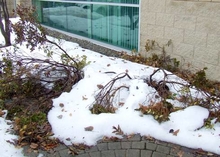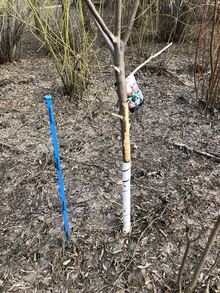After the snow and drifts melt on our urban and rural landscapes, homeowners may want to cruise their property to look for winter damage to woody plants. These woody plants need to be inspected for snow, winter burn and wildlife damage after the snow melts, and then pruned if necessary.
Snow drift damage and pruning
The weight of snow as it melts, as well as the freeze-thaw cycle in the spring, can apply a downward pressure on branches. Some of these branches may crack or break on landscape trees and shrubs, causing permanent damage. Foundation plantings may have more damage due to snow being roof-raked and landing on these plants.
If woody plant branches are cracked or broken, they should be pruned in the spring. The damaged limbs of woody shrubs can be pruned individually or if the majority of the shrub limbs are broken, a complete rejuvenation prune may be best. A complete rejuvenation prune is when all the branches of the shrub are pruned down to one or two inches above the ground. It may sound scary, but don’t worry! The shrub will grow back.
Woody shrubs are usually more forgiving than evergreens, yews or conifers. Broken conifer limbs usually do not recover and eventually die. Thus these limbs should be pruned. In some cases a “wait and see” method of pruning management is a good idea to see what limbs survive and which limbs need to be pruned. Conifer limbs that are damaged or died may take up to 6 months to change needle color from green to brown.
Learn how and when to prune trees and shrubs.
Browning of conifer needles
Many conifer trees and shrubs can suffer from winter burn or damage from cold winter winds. Again, a “wait and see” management strategy may be recommended to see if these limbs might recover in a few months. If the winter burn is severe, the tree/shrub may need to be replaced with a more tolerant winter conifer. Conifers susceptible to winter burn should be wrapped in burlap or a tree cover in the fall, and the wrap should be removed in the spring.
The browning of spruce needles on the lower limbs may be caused by needle cast diseases instead of winter injury. Needle cast diseases are becoming more of a problem in spruce.
Wildlife damage
Urban and rural landscapes have wildlife that can damage trees and shrubs. Voles, rabbits and deer can kill stems and entire woody plants by girdling the bark. Girdling is the removal of the bark layer around the circumference of a tree or shrub, and it will kill the stem or plant by preventing transportation of nutrients from the leaves to the roots.
Voles gnaw on the tree or shrub bark at ground level underneath the snow. Remove excessive grass and mulch from the tree/shrub in the fall to prevent this damage.
Rabbits are a major winter predator of trees and shrubs. Young preferred plants (fruit trees, mostly) need to be protected with tree tubes or other protection. If snow drifts are high (3-4 feet) rabbits have been known to walk on drifts over the protection and gnaw on the bark and kill the tree at the height of the drift.
Deer can browse and eat the bark and limbs of trees, but the most common damage is from the bucks rubbing their antlers up and down the tree, removing the bark and girdling the tree. Tree tubes, fencing and repellants may be used to help protect trees.
Learn more about protecting trees and shrubs in winter.



